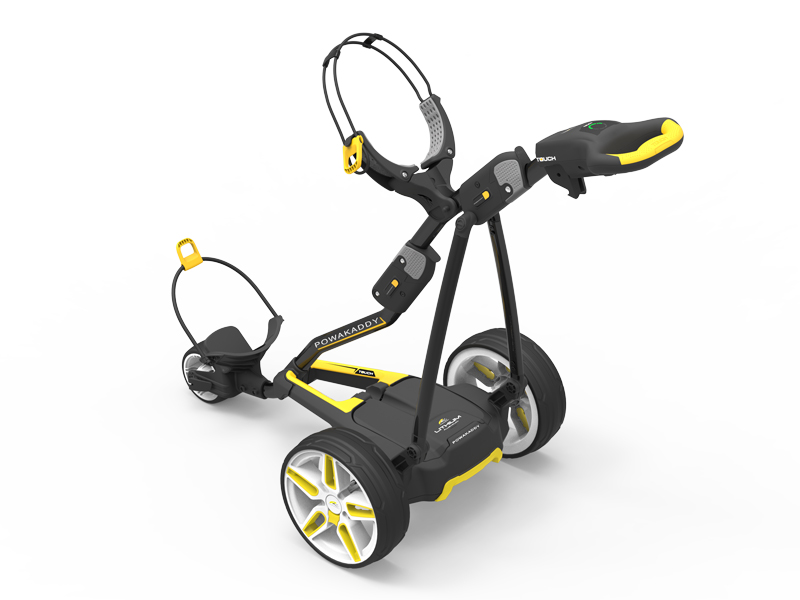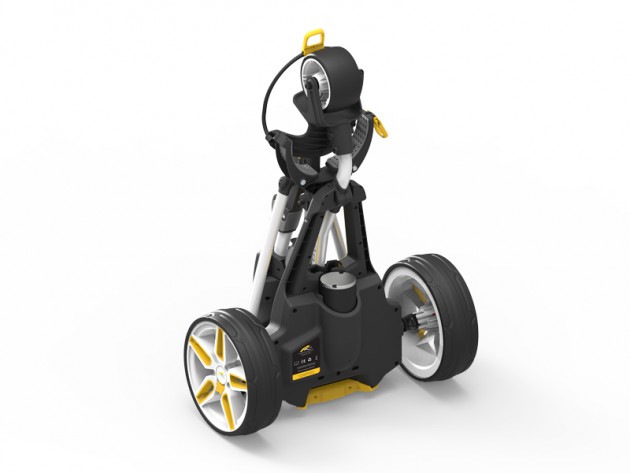PowaKaddy Touch
We review PowaKaddy's latest electric trolley that automatically adjusts to your walking pace

The Touch is an innovative alternative in the electric trolley market that golfers will enjoy. The lightweight frame and battery options combined with the modern styling and functionality make it an appealing prospect. Whether it's preferable to a conventionally operated, button-style electric trolley will vary from golfer to golfer.
-
+
On relatively flat terrain the Touch trolley is a joy to use. It's is quick and simple to assemble and get going. Once you learn to be gentle with the handle, many golfers will prefer how it adjusts to walking pace over a conventional electric trolley.
-
-
Controlling the speed can be difficult initially, with too much force when travelling up or down hills creating jerky movements at times.
Why you can trust Golf Monthly

Golf Monthly Technical Editor Joel Tadman's PowaKaddy Touch review, a new 'touch 'n' go' electric trolley said to automatically adjust to your walking pace
Key Tech This new ‘touch n go’ trolley from PowaKaddy is designed to automatically adjust to your walking pace. The trolley comes with a two-year warranty; the lithium battery five years. It features new low profile deluxe wheels, a USB charging port and bungee straps with anti-pinch handles to keep your bag in place.
Styling The Touch boasts a modern, sleek look. Both the white frames work well visually with the eye-catching, signature yellow trim. New low-profile wheels, a rear diffuser and stylish, ambidextrous handle complete the cutting-edge look.
Battery The PowaKaddy Plug ‘N’ play lithium battery slides in effortlessly and removes the need for fiddly loose wires that look untidy and can be time consuming to connect up. At just 2kg, it’s extremely lightweight and compact. On a relatively flat course you’ll still have more than half charge left after 18 holes from a full charge. If you tend to play 36 holes in a day on more undulating terrain, the extended lithium battery will be worth the upgrade.

Chassis and Frame The chassis is made from a strong and lightweight engineering polymer, which makes it robust but easy to lift in and out of your car even with the battery connected. It is quick and simple to assemble and fold down thanks to its three-way folding mechanism, which is very user friendly and intuitive to grasp at the first attempt.
Operation Once turned on via a button underneath the control unit, a circular red LED light will flash on the display. Gently push the handle as you start walking, the console will slide in and the light will change to green. The further inwards you push the handle, the faster the trolley will move, matching your walking pace. As you slow down, the control unit will slide back out naturally, slowing the trolley in unison. To stop, you simply hold the handle and stop walking.
Steering This works in the same way as a normal electric trolley by twisting the direction with your hands. Be sure to remember to put the trolley in stand by mode using the button when stationary to eliminate the fear of bumping the handle with your hip and setting it off inadvertently.

Features The touch control method is the trolley’s stand out feature but there is also a USB charging port for you to connect your smartphone or GPS device. Accessories like a GPS cradle or umbrella holder (sold separately) can be attached to the frame. The key lock base on PowaKaddy’s cart bag range eliminate any unwanted movement but standbags from any brand are secured well enough via the elasticated straps.
Ease of use This is one of the quickest and simplest trolleys to get going once you arrive in the car park. It takes time to adjust to the control system and how it differs to a conventional electric trolley, which will resume at the speed it was set to previously. But once you learn to be gentle when pushing the handle initially to resume walking after playing a shot. Once you’ve found your ideal walking pace, you can take your hand off and it will continue at the same speed.
Control The ambidextrous handle makes it just as easy to maneuver as a conventional electric trolley. Going down hills the movement can become a little jolty as the trolley adjusts to your new step pattern but providing you don’t tug or push forcefully on the control unit, you shouldn’t be inconvenienced.
Get the Golf Monthly Newsletter
Subscribe to the Golf Monthly newsletter to stay up to date with all the latest tour news, equipment news, reviews, head-to-heads and buyer’s guides from our team of experienced experts.

Joel has worked in the golf industry for over 15 years covering both instruction and more recently equipment. He now oversees all equipment and video content at Golf Monthly, managing a team of talented and passionate writers and presenters in delivering the most thorough and accurate reviews, buying advice, comparisons and deals to help the reader or viewer find exactly what they are looking for.
One of his career highlights came when covering the 2012 Masters he got to play the sacred Augusta National course on the Monday after the tournament concluded, shooting a respectable 86 with just one par and four birdies. To date, his best ever round of golf is a 5-under 67 back in 2011. He currently plays his golf at Burghley Park Golf Club in Stamford, Lincs, with a handicap index of 3.1.
Joel's current What's In The Bag?
Driver: Titleist GT3, 9°, Fujikura Ventus Black 6 S shaft.
Fairway wood: Titleist TSR3, 15°
Hybrid: Titleist TSi2, 18°
Irons: Titleist T150, 4-PW
Wedges: Titleist Vokey SM10, 50°, 54° and 58°
Putter: LAB Golf DF3
Ball: 2025 Titleist Pro V1x
-
 Chevron Championship Tee Times: Rounds One And Two
Chevron Championship Tee Times: Rounds One And TwoA look at when the players are teeing it up in the opening two rounds of the Chevron Championship - the first women's Major of the year
By Mike Hall Published
-
 Charley Hull Social Media Video Reveals Brutal Weather Conditions Ahead Of Chevron Championship
Charley Hull Social Media Video Reveals Brutal Weather Conditions Ahead Of Chevron ChampionshipCharley Hull has added a video to her Instagram stories showing strong wind and heavy rain in Texas ahead of the first women's Major of the year
By Mike Hall Published
-
 How To Watch Chevron Championship 2025: Live Streams, TV Channels, Schedule
How To Watch Chevron Championship 2025: Live Streams, TV Channels, ScheduleAll the details on how to watch Chevron Championship online and on TV from anywhere, as the first women's Major of 2025 takes place at Carlton Woods this week.
By Roderick Easdale Published